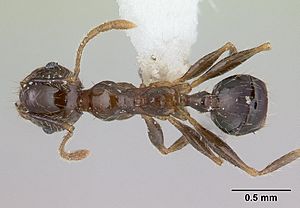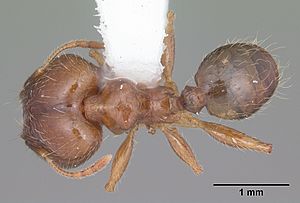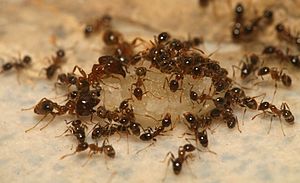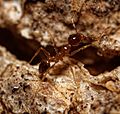Big-headed ant facts for kids
Quick facts for kids Pheidole megacephala |
|
|---|---|
 |
|
| Dorsal view of worker big-headed ant | |
| Scientific classification | |
| Kingdom: | |
| Phylum: | |
| Class: |
Insecta Myrmica suspiciosa Smith 1859
Myrmica trinodis Losana 1834 Oecophthora perniciosa Gerstacker 1859 Oecophthora pusilla Heer 1852 Pheidole janus F. Smith Pheidole laevigata Mayr |
The Pheidole megacephala is a type of ant. It belongs to the Formicidae family. People often call it the big-headed ant in the USA. In Australia, it's known as the coastal brown ant. This ant is very good at spreading to new places. It can cause problems for native ants and other species. Because of this, it's listed as one of the "World's worst" invasive species.
Contents
Where Do Big-Headed Ants Live?
The big-headed ant was first described in 1793. This happened on the island of Mauritius. An insect expert named Johan Christian Fabricius studied it. However, there's a record from 1775 in Egypt. It was called Formica edax back then. No matter where it first came from, big-headed ants have spread widely. You can now find them in many warm, tropical, and subtropical parts of the world.
What Do Big-Headed Ants Look Like?
There are two main kinds of worker ants in a big-headed ant colony. One is the major worker, also called a soldier ant. The other is the minor worker. The soldier ant gets its name from its very large head. This head has strong mandibles. These are like jaws that can crush seeds.
Soldier ants are about four millimeters long. This is twice as long as the minor workers. Both types of ants can be yellowish-brown, reddish-brown, or almost black. The back part of their head is smooth and shiny. The front part has a textured pattern. Their antennae have twelve segments and are curved. They have club-like tips. The ant's waist, or petiole, has two parts. The part right behind the body is noticeably swollen. There are also two short, upward-pointing spines on their waist. Their bodies have a few long hairs.
How Do Big-Headed Ants Live?
Big-headed ants build their colonies underground. Some colonies can have many queens. Very large colonies, called super-colonies, can form by "budding." This means a queen and some workers leave the main nest. They then start a new colony nearby. They don't need to swarm like some other ants.
In Florida, winged ants have special "nuptial flights." These flights happen during winter and spring. After flying, fertilized queens lose their wings. They find a good spot to start a new colony. There, they begin laying eggs. Each queen can lay up to 290 eggs every month! The eggs hatch in two to four weeks. The young ants are white, legless larvae. Worker ants feed them. About a month later, the larvae turn into pupae. Adult workers then emerge ten to twenty days after that.
What Do Big-Headed Ants Eat?
Big-headed ants eat many different things. They feed on dead insects and small invertebrates. They also love honeydew. Honeydew is a sweet liquid. It's made by insects like aphids, soft scale insects, mealybugs, whiteflies, and planthoppers. These sap-sucking bugs actually do better when big-headed ants are around. This is because the ants protect them from predators.
Big-headed ants also hunt the eggs of various moths. For example, they prey on the eggs of the African sugarcane borer. This moth is common in parts of Africa. The ants also protect their food sources. For instance, they helped Coccus viridis (green scale) thrive. They did this by removing predators like lady beetle larvae and other insect larvae.
How Do They Find Food?
Minor workers are much more common than soldier ants. You can see trails of ants going up tree trunks and along branches. They even go into the leafy tops of trees. On the ground, they build tunnels covered with debris. These tunnels have many entrances. Sometimes, people confuse them with tunnels made by underground termites. When foraging ants find new food, they tell other ants. Honeydew is eaten on the spot. But other food items are carried back to the nest. Both major and minor workers do this. They might even pass food items to each other. If something is too big to move, they will cut it into smaller pieces. Then they carry these pieces back to the nest.
P. megacephala can also live inside buildings.
Images for kids
See also
 In Spanish: Pheidole megacephala para niños
In Spanish: Pheidole megacephala para niños




